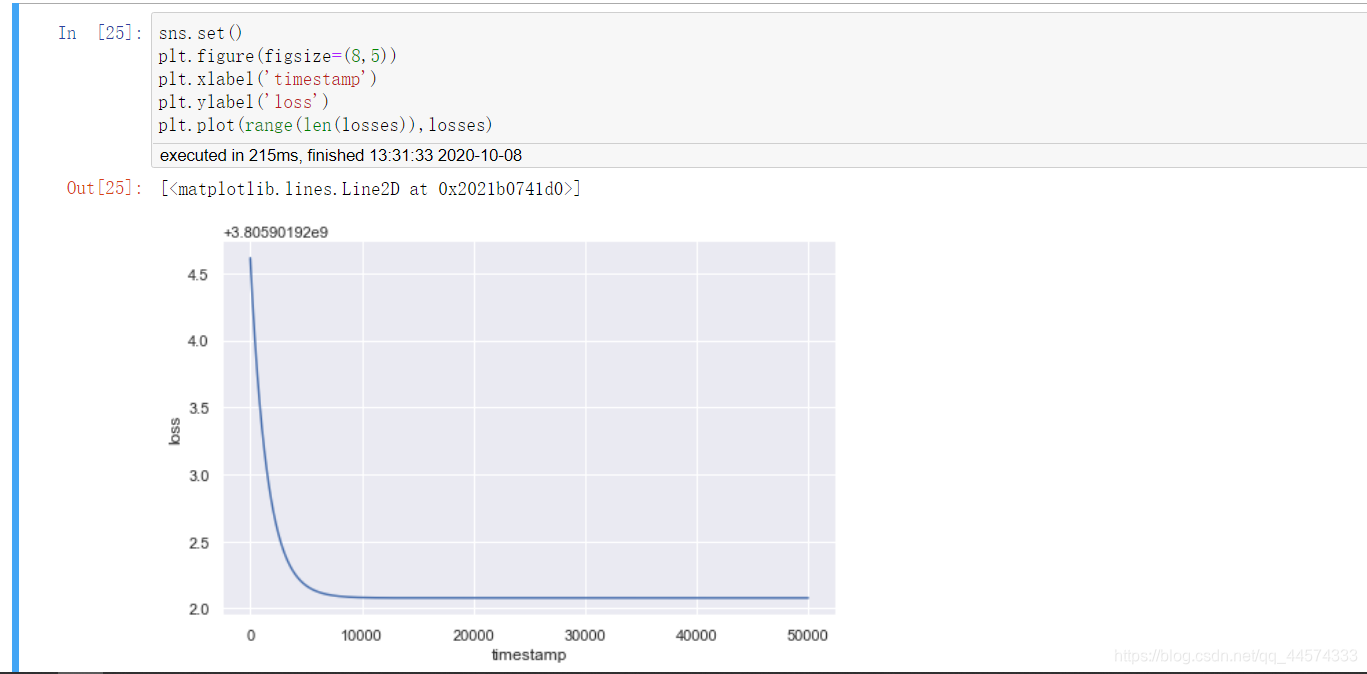从头构建神经网络
Building a neural network from sractch
仅用numpy实现神经网络,并用于实际的回归预测任务
目录
I 数据集
数据集来源国家统计局
注:
1.铁路运输数据来源于中国国家铁路集团有限公司、公路水路运输数据来源于交通运输部,民航运输数据来源于中国民用航空局。
2.自2020年1月起,交通运输部根据2019道路货物运输量专项调查调整月度公路货物运输量、公路货物运输周转量统计口径,同比增速按照调整后可比口径计算。
3.自2020年1月起,水路运输(海洋)统计方式改变,由行业主管部门报送调整为企业联网直报,2020年以可比口径计算增速。
4.从2015年1月起,铁路客运统计口径发生变化,由按售票数统计改为按乘车人数统计。
5.根据2013年开展的交通运输业经济统计专项调查,我部对公路水路运输量的统计口径和推算方案进行了调整。有关2014年月度公路水路客货运输量均按新方案推算并进行更新。
数据来源:国家统计局
数据集读取
import numpy as np
import pandas as pd
from sklearn.utils import resample
data = pd.read_csv('国家统计局月度数据统计.csv',encoding='gbk')
print('Shape:',data.shape)
data.head()

划分X和Y,我们的目的就是希望训练一个神经网络来通过上图data各列数据去预测客运量当期值(万人),回归预测。
具体而言,通过2013年1月的所有数据(一整行)去预测2013年2月的客运量当期值(万人),通过2013年2月的所有数据(一整行)去预测2013年3月的客运量当期值(万人).
# 空值填充
data.fillna(0,inplace=True)
num_columns = [i for i in data.columns if i not in ['时间']]
X_ = data[num_columns].values[:-1]
Y_ = data['客运量当期值(万人)'].values[1:]
X_ = (X_ - np.mean(X_ , axis=0)) / np.std(X_ , axis = 0)
print(len(X_),len(Y_))
print('第一个Y为',Y_[0],'最后一个Y为',Y_[-1])
数据集部分不再阐述,让我们主要关注神经网络的构建。
II 神经网络构建
2.1 构建基类
首先让我们明确神经网络中应该有的模块及功能:
- Forward:前向传播 Funtion , how to calculate the inputs
- Backforward:反向传播BP Funtion , how to get the gredients when backprogramming
- Gradient:梯度“下降” Mapper ,the gradient map the this node of its inputs node
- Inputs:输入 List, the input nodes of this node
- Outputs:输出 List , the output node of this node
2.1.1 Node
简单来说每个节点的作用是这样的:
I
n
p
u
t
−
>
L
i
n
e
a
r
−
>
A
c
t
i
v
a
t
i
o
n
Input -> Linear -> Activation
Input−>Linear−>Activation
通俗理解就是
(
x
−
>
k
∗
x
+
b
−
>
s
i
g
m
o
i
d
)
(x -> k * x + b ->sigmoid)
(x−>k∗x+b−>sigmoid)
因为在神经网络中又包含函数、字典、列表这些共同特性,让我们用面向对象的方式来组织这个框架
构建基类代码实现如下
class Node:
"""
Each node in neural networks will have these attributes and methods
"""
def __init__(self,inputs=[]):
"""
if the node is operator of "ax + b" , the inputs will be x node , and the outputs
of this is its successors , and the value is *ax + b*
"""
self.inputs = inputs
self.outputs = []
self.value = None
self.gradients = { }
for node in self.inputs:
node.outputs.append(self) # bulid a connection relationship
def forward(self):
"""Forward propogation
compute the output value based on input nodes and store the value
into *self.value*
"""
# 虚类
# 如果一个对象是它的子类,就必须要重新实现这个方法
raise NotImplemented
def backward(self):
"""Backward propogation
compute the gradient of each input node and store the value
into *self.gradients*
"""
# 虚类
# 如果一个对象是它的子类,就必须要重新实现这个方法
raise NotImplemented
2.1.2 Input
神经网络的输入节点定义如下,对于每个输入节点,都有两个属性:
- forward:前向传播计算值
- backward:反向传播,更新参数
class Input(Node):
def __init__(self, name=''):
Node.__init__(self, inputs=[])
self.name = name
def forward(self, value=None):
if value is not None:
self.value = value
def backward(self):
self.gradients = {}
for n in self.outputs:
grad_cost = n.gradients[self]
self.gradients[self] = grad_cost
def __repr__(self):
return 'Input Node: {}'.format(self.name)
2.1.3 Linear
神经网络中的线性层如下
对于线性层,我们定义了 “wx+b”的前向计算,和反向传播时需要的对w、x、b参数的梯度值
class Linear(Node):
def __init__(self, nodes, weights, bias):
self.w_node = weights
self.x_node = nodes
self.b_node = bias
Node.__init__(self, inputs=[nodes, weights, bias])
def forward(self):
"""compute the wx + b using numpy"""
self.value = np.dot(self.x_node.value, self.w_node.value) + self.b_node.value
def backward(self):
for node in self.outputs:
#gradient_of_loss_of_this_output_node = node.gradient[self]
grad_cost = node.gradients[self]
self.gradients[self.w_node] = np.dot(self.x_node.value.T, grad_cost) # loss对w的偏导 = loss对self的偏导 * self对w的偏导
self.gradients[self.b_node] = np.sum(grad_cost * 1, axis=0, keepdims=False)
self.gradients[self.x_node] = np.dot(grad_cost, self.w_node.value.T)
2.1.4 Sigmoid
神经网络中的激活函数如下,数学定义式,不再阐述
class Sigmoid(Node):
def __init__(self, node):
Node.__init__(self, [node])
self.x_node = node
def _sigmoid(self, x):
return 1. / (1 + np.exp(-1 * x))
def forward(self):
self.value = self._sigmoid(self.x_node.value)
def backward(self):
y = self.value
self.partial = y * (1 - y)
for n in self.outputs:
grad_cost = n.gradients[self]
self.gradients[self.x_node] = grad_cost * self.partial
2.1.5 MSE
神经网络中的损失函数MSE定义,数学定义式,不再阐述
class MSE(Node):
def __init__(self, y_true, y_hat):
self.y_true_node = y_true
self.y_hat_node = y_hat
Node.__init__(self, inputs=[y_true, y_hat])
def forward(self):
y_true_flatten = self.y_true_node.value.reshape(-1, 1)
y_hat_flatten = self.y_hat_node.value.reshape(-1, 1)
self.diff = y_true_flatten - y_hat_flatten
self.value = np.mean(self.diff**2)
def backward(self):
n = self.y_hat_node.value.shape[0]
self.gradients[self.y_true_node] = (2 / n) * self.diff
self.gradients[self.y_hat_node] = (-2 / n) * self.diff
2.2 构建图
有关拓扑图的定义如下,在此你只需知道拓扑排序将神经网络中的各个节点进行有序排序,设定其有效的入度和出度。
def topological_sort(data_with_value):
feed_dict = data_with_value
input_nodes = [n for n in feed_dict.keys()]
G = {}
nodes = [n for n in input_nodes]
while len(nodes) > 0:
n = nodes.pop(0)
if n not in G:
G[n] = {'in': set(), 'out': set()}
for m in n.outputs:
if m not in G:
G[m] = {'in': set(), 'out': set()}
G[n]['out'].add(m)
G[m]['in'].add(n)
nodes.append(m)
L = []
S = set(input_nodes)
while len(S) > 0:
n = S.pop()
if isinstance(n, Input):
n.value = feed_dict[n]
## if n is Input Node, set n'value as
## feed_dict[n]
## else, n's value is caculate as its
## inbounds
L.append(n)
for m in n.outputs:
G[n]['out'].remove(m)
G[m]['in'].remove(n)
# if no other incoming edges add to S
if len(G[m]['in']) == 0:
S.add(m)
return L
def training_one_batch(topological_sorted_graph):
# graph 是经过拓扑排序之后的 一个list
for node in topological_sorted_graph:
node.forward()
for node in topological_sorted_graph[::-1]:
node.backward()
def sgd_update(trainable_nodes, learning_rate=1e-2):
for t in trainable_nodes:
t.value += -1 * learning_rate * t.gradients[t]
def run(dictionary):
return topological_sort(dictionary)
接下来,让我们定义神经网络每层的权重、输入输出,我们只设置了两个线性层
n_features = X_.shape[1]
n_hidden = 10
n_hidden_2 = 10
W1_ = np.random.randn(n_features , n_hidden)
b1_ = np.zeros(n_hidden)
W2_ = np.random.randn(n_hidden,1)
b2_ = np.zeros(1)
X, Y = Input(name='X'), Input(name='y') # tensorflow -> placeholder
W1, b1 = Input(name='W1'), Input(name='b1')
W2, b2 = Input(name='W2'), Input(name='b2')
接下来,让我们定义神经网络的层
linear_output = Linear(X, W1, b1)
sigmoid_output = Sigmoid(linear_output)
Yhat = Linear(sigmoid_output, W2, b2)
loss = MSE(Y, Yhat)
让我们看一下我们输入输出经过拓扑排序后得到的神经网络图
input_node_with_value = { # -> feed_dict
X:X_,
Y:Y_,
W1:W1_,
W2:W2_,
b1:b1_,
b2:b2_
}
graph = topological_sort(input_node_with_value)
graph

III 训练
losses = []
epochs = 50000
batch_size = 64
steps_per_epoch = X_.shape[0] // batch_size
learning_rate = 0.1
for i in range(epochs):
loss = 0
for batch in range(steps_per_epoch):
X_batch, Y_batch = resample(X_, Y_, n_samples=batch_size)
X.value = X_batch
Y.value = Y_batch
training_one_batch(graph)
sgd_update(trainable_nodes=[W1, W2, b1, b2], learning_rate=learning_rate)
loss += graph[-1].value
if i % 100 == 0:
print('Epoch: {}, loss = {:.3f}'.format(i+1, loss/steps_per_epoch))
losses.append(loss)
让我们看一下实现效果
import seaborn as sns
import matplotlib.pyplot as plt
%matplotlib inline
sns.set()
plt.figure(figsize=(8,5))
plt.xlabel('timestamp')
plt.ylabel('loss')
plt.plot(range(len(losses)),losses)

仅用两个线性层即可实现如此的回归效果也还是可以的了,各位可以尝试通过增加线性层和激活函数来优化回归效果。
最后让我们看一下预测效果:


可以看出我们的预测效果还是可以接受的。
完整数据和代码文件请见Github:























 1775
1775











 被折叠的 条评论
为什么被折叠?
被折叠的 条评论
为什么被折叠?










